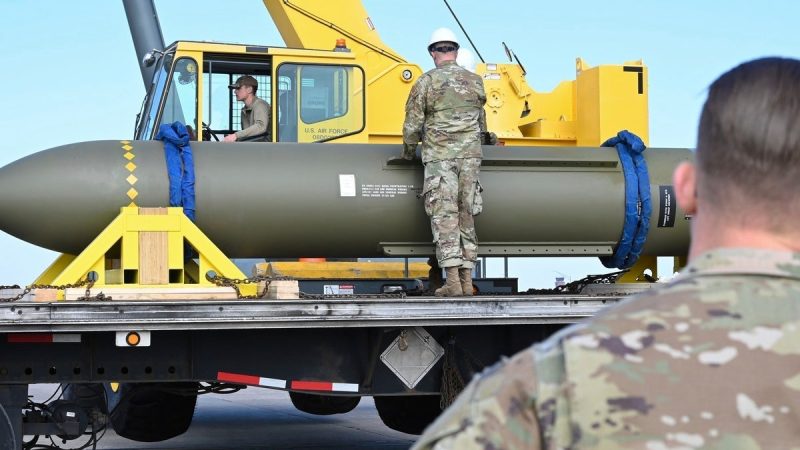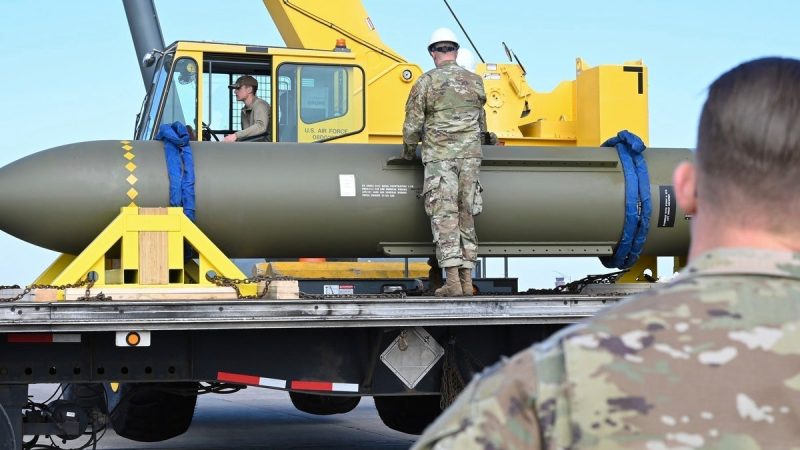
While President Donald Trump has asserted that the military’s weekend strike against Iran ‘completely and totally obliterated’ its nuclear weapon-making capabilities, there are still questions about whether the ground-penetrating ‘bunker buster’ bombs used to attack Iran’s key enrichment sites were enough to stop the rogue country from developing a nuclear bomb.
A report released last week by the Center for Strategic and International Studies (CSIS) explains that the special ‘bunker buster’ bombs the U.S. used in Iran over the weekend that everyone is talking about, known as GBU-57 Massive Ordnance Penetrators, or MOPs, might not be able to fully destroy the Iranian nuclear facility at Fordow. Fordow, which Trump said was ‘gone’ now following the strike, is considered central to Iran’s nuclear weapon-making capabilities.
Meanwhile, a satellite imagery expert relayed to Reuters that confirmation of below-ground destruction could not be determined via pictures alone, because the facility’s hundreds of centrifuges are too deeply buried in order to make an accurate determination.
‘I actually have a little bit of a rosier view on things,’ Andrea Stricker, Deputy Director at the Foundation for Defense of Democracies’ Nonproliferation and Biodefense Program, told Fox News Digital. ‘I think that because of the massive damage and the shock wave that would have been sent by 12 Massive Ordnance Penetrators at the Fordow site, that it likely would render its centrifuges damaged or inoperable.’
Stricker noted that centrifuges are ‘very delicate’ and the kind of shock wave coming from the MOPs would at least put them ‘out of commission.’ She also said if any centrifuges did survive the blasts, it would be likely that they would be inaccessible by Iranian authorities for several months.
‘Underground facilities present a difficult target, not only for destruction, but also in terms of follow-on battle damage assessment,’ added Wes Rumbaugh, a fellow in the Missile Defense Project at CSIS. ‘The United States and Israel will likely need to invest additional intelligence resources to determine the true extent of the damage from the U.S. strikes and their long-term effect on Iranian nuclear infrastructure.’
In addition to Fordow, the U.S. used its MOPs at an Iranian enrichment facility called Natanz, where, according to Stricker, at least 1,000 centrifuges are located, as well as an above-ground enrichment plant and other labs capable of making uranium metal.
According to the International Atomic Energy Agency (IAEA) the above-ground labs had previously been damaged by Israeli airstrikes, destroying the plant’s electrical infrastructure. Meanwhile, satellite imagery following the U.S.’s decision to drop two MOPs on Natanz show two craters located where the site’s underground enrichment facilities are reportedly located. However, it is still not clear if the U.S. attacks completely destroyed the underground nuclear infrastructure.
Either way, Striker noted, the significant damage to Iran’s Natanz facility will create a ‘bottleneck’ in the country’s supply chain for weapons-grade uranium, which will significantly impact Iran’s nuclear weapon-making capabilities.
The third site targeted by the U.S.’s airstrikes was Iran’s Isfahan nuclear enrichment facility, but MOPs were not used at that site. Instead, the U.S. used Tomahawk cruise missiles, which the IAEA confirmed caused significant damage. Satellite imagery reportedly shows Isfahan’s above-ground facilities were taken out, but it remains unclear the extent of the damage to the site’s underground sections.
One of the biggest outstanding questions regarding the success of the United States’ weekend strike on Iran’s nuclear facilities, is whether authorities in the country were able to move their nuclear materials from the targeted sites before the U.S. launched its missiles at them. But, according to CSIS’s Bumbaugh, even if that is the case and Iran moved their nuclear materials, the chaos would still make it hard for Iran to ‘sprint to a nuclear weapon.’
‘Having to move these assets to new facilities likely degrades Iran’s immediate ability to sprint to a nuclear weapon but makes it likely that Iran will go to great lengths to conceal their new location,’ Bumbaugh said. ‘This movement of nuclear infrastructure or material would make follow-on strikes difficult if intelligence is unable to find all of the new hidden facilities.’
‘There’s a lot of alarmism right now about whether Iran could sprint to a bomb,’ Stricker added. ‘Israel has done so much damage to their ability to make nuclear weapons [and] the weaponization supply chain. So the facilities, the components that [Iran] would need, the equipment, and then up to 14 nuclear scientists, I think, if they did want to build a bomb quickly, they’re really stymieing – they don’t have access to all of all that, all of those assets they would need. And so, I think in the short to medium term, we don’t need to be overly concerned that they could get there.’
Fox News Digital reached out to both the Pentagon and the Air Force to glean more details about the success of the weekend strike on Iran, but no new information was gleaned.
An Air Force spokesperson did confirm to Fox News Digital that, in total, U.S. forces deployed 75 ‘precision guided weapons’ targeting Iran over the weekend, including 14 30,000 pound GBU-57 Massive Ordnance Penetrators.
On Monday, Rafael Grossi, head of the IAEA, appealed for immediate access to the targeted Iranian nuclear sites in order to assess the damage that is likely ‘significant,’ according to the United Nations.

